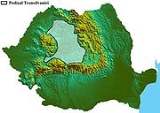
Transylvanian Plateau
Encyclopedia

Plateau
In geology and earth science, a plateau , also called a high plain or tableland, is an area of highland, usually consisting of relatively flat terrain. A highly eroded plateau is called a dissected plateau...
in central Romania
Romania
Romania is a country located at the crossroads of Central and Southeastern Europe, on the Lower Danube, within and outside the Carpathian arch, bordering on the Black Sea...
.
The plateau lies within and takes its name from the historical region of Transylvania
Transylvania
Transylvania is a historical region in the central part of Romania. Bounded on the east and south by the Carpathian mountain range, historical Transylvania extended in the west to the Apuseni Mountains; however, the term sometimes encompasses not only Transylvania proper, but also the historical...
, and is almost entirely surrounded by the Eastern, Southern
Southern Carpathians
The Southern Carpathians or the Transylvanian Alps are a group of mountain ranges which divide central and southern Romania, on one side, and Serbia, on the other side. They cover part of the Carpathian Mountains that is located between the Prahova River in the east and the Timiș and Cerna Rivers...
and Romanian Western
Apuseni Mountains
The Apuseni Mountains is a mountain range in Transylvania, Romania, which belongs to the Western Carpathians, also called Occidentali in Romanian. Their name translates from Romanian as Mountains "of the sunset" i.e. "western". The highest peak is "Cucurbăta Mare" - 1849 metres, also called Bihor...
branches of the Carpathian Mountains
Carpathian Mountains
The Carpathian Mountains or Carpathians are a range of mountains forming an arc roughly long across Central and Eastern Europe, making them the second-longest mountain range in Europe...
. The area includes the Transylvanian Plain
Transylvanian Plain
The Transylvanian Plain is an ethnogeographical area in Transylvania, Romania, located between the Someş River and the Mureş River....
.
It is improperly called a plateau, for it does not possess extensive plains, but is formed of a network of valleys of various size, ravines and canyon
Canyon
A canyon or gorge is a deep ravine between cliffs often carved from the landscape by a river. Rivers have a natural tendency to reach a baseline elevation, which is the same elevation as the body of water it will eventually drain into. This forms a canyon. Most canyons were formed by a process of...
s, united together by numerous small mountain range
Mountain range
A mountain range is a single, large mass consisting of a succession of mountains or narrowly spaced mountain ridges, with or without peaks, closely related in position, direction, formation, and age; a component part of a mountain system or of a mountain chain...
s, which attain a height of 150-250 m (500-800 ft) above the altitude of the valley.
The plateau has a continental climate
Continental climate
Continental climate is a climate characterized by important annual variation in temperature due to the lack of significant bodies of water nearby...
. Temperature varies a great deal in the course of a year, with warm summers contrasted by very cold winters. Vast forests cover parts of the plateau and the mountains. The mean elevation is 300-500 m (1,000-1,600 ft).
External links
- http://archive.soschildrensvillages.org.uk/sponsor-child/country_information_on_romania.html
- http://www.globalvolunteers.org/1main/romania/romaniageography.htm

